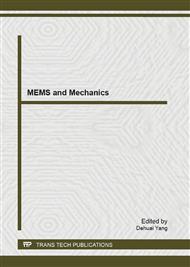[1]
P. Linse, Interaction between colloids with grafted diblock polyampholytes, J. Chem. Phys., 126 (2007), 114903.
DOI: 10.1063/1.2436874
Google Scholar
[2]
X. Ding, C. Yang, T. P. Lim, L. Y. Hsu, A. C. Engler, J. L. Hedrick, Y. Y. Yang, Antibacterial and antifouling catheter coatings using surface grafted PEG-b-cationic polycarbonate diblock copolymers, Biomaterials, 33 (2012), 6593-6603.
DOI: 10.1016/j.biomaterials.2012.06.001
Google Scholar
[3]
O. Hollmann, C. Reichhart, C. Czeslik, Kinetics of protein adsorption at a poly(acrylic acid) brush studied by surface plasmon resonance spectroscopy, Z. Phys. Chemie-Int. J. Res. Phys. Chem. Chem. Phys., 222 (2008), 205-215.
DOI: 10.1524/zpch.2008.222.1.205
Google Scholar
[4]
X. Zhang, A. B. Sushkov, C. J. Metting, S. Fackler, H. D. Drew, R. M. Briber, Silicon Patterning Using Self-assembled PS-b-PAA Diblock Copolymer Masks for Black Silicon Fabrication via Plasma Etching, Plasma Process. Polym., 9 (2012), 968-974.
DOI: 10.1002/ppap.201100198
Google Scholar
[5]
B. Fang, S. Gon, M. Park, K. N. Kumar, V. M. Rotello, K. Nusslein, M. M. Santore, Bacterial adhesion on hybrid cationic nanoparticle-polymer brush surfaces: Ionic strength tunes capture from monovalent to multivalent binding, Colloid Surf. B-Biointerfaces, 87 (2011), 109-115.
DOI: 10.1016/j.colsurfb.2011.05.010
Google Scholar
[6]
S. C. Kim, B. S. Seong, Adsorption of the heteronuclear AB diblock copolymers confined in the slitlike pores, The Journal of chemical physics, 132 (2010), 024705-024705-024709.
DOI: 10.1063/1.3292003
Google Scholar
[7]
C. Suchomski, C. Reitz, K. Brezesinski, C. T. de Sousa, M. Rohnke, K. Iimura, J. P. E. de Araujo, T. Brezesinski, Structural, Optical, and Magnetic Properties of Highly Ordered Mesoporous MCr2O4 and MCr2-xFexO4 (M = Co, Zn) Spinel Thin Films with Uniform 15 nm Diameter Pores and Tunable Nanocrystalline Domain Sizes, Chem. Mat., 24 (2012), 155-165.
DOI: 10.1021/cm2026043
Google Scholar
[8]
R. Jiang, B. H. Li, Z. Wang, Y. H. Yin, A. C. Shi, Self-Assembled Morphologies of Diblock Copolymer Brushes in Poor Solvents, Macromolecules, 45 (2012), 4920-4931.
DOI: 10.1021/ma300564r
Google Scholar
[9]
A. Striolo, Surface adsorption of colloidal brushes at good solvents conditions, J. Chem. Phys., 137 (2012).
Google Scholar
[10]
E. Bittrich, S. Burkert, M. Muller, K. J. Eichhorn, M. Stamm, P. Uhlmann, Temperature-Sensitive Swelling of Poly(N-isopropylacrylamide) Brushes with Low Molecular Weight and Grafting Density, Langmuir, 28 (2012), 3439-3448.
DOI: 10.1021/la204230a
Google Scholar
[11]
S. Tugulu, P. Silacci, N. Stergiopulos, H. A. Klok, RGD - Functionalized polymer brushes as substrates for the integrin specific adhesion of human umbilical vein endothelial cells, Biomaterials, 28 (2007), 2536-2546.
DOI: 10.1016/j.biomaterials.2007.02.006
Google Scholar
[12]
K. Yu, Y. C. Han, Effect of block sequence and block length on the stimuli-responsive behavior of polyampholyte brushes: hydrogen bonding and electrostatic interaction as the driving force for surface rearrangement, Soft Matter, 5 (2009), 759-768.
DOI: 10.1039/b805611k
Google Scholar
[13]
S. Tugulu, K. Lowe, D. Scharnweber, F. Schlottig, Preparation of superhydrophilic microrough titanium implant surfaces by alkali treatment, J. Mater. Sci.-Mater. Med., 21 (2010), 2751-2763.
DOI: 10.1007/s10856-010-4138-x
Google Scholar
[14]
A. Ramirez-Hernandez, G. L. Liu, P. F. Nealey, J. J. de Pablo, Symmetric Diblock Copolymers Confined by Two Nanopatterned Surfaces, Macromolecules, 45 (2012), 2588-2596.
DOI: 10.1021/ma2026594
Google Scholar
[15]
F. Tessier, G. W. Slater, Modulation of electroosmotic flow strength with end-grafted polymer chains, Macromolecules, 39 (2006), 1250-1260.
DOI: 10.1021/ma0522211
Google Scholar
[16]
K. Kremer, G. S. Grest, Dynamics of entangled linear polymer melts: A molecular‐dynamics simulation, J. Chem. Phys., 92 (1990), 5057.
DOI: 10.1063/1.458541
Google Scholar
[17]
M. Borówko, W. Rzysko, S. Sokolowski, T. Staszewski, Adsorption of short heteropolymers in slitlike pores, J. Coll. Inter. Sci., 314 (2007), 349-357.
DOI: 10.1016/j.jcis.2007.05.076
Google Scholar
[18]
Y. K. Jhon, S. Arifuzzaman, A. E. Özçam, D. J. Kiserow, J. Genzer, Formation of Polyampholyte Brushes via Controlled Radical Polymerization and Their Assembly in Solution, Langmuir, 28 (2011), 872-882.
DOI: 10.1021/la203697a
Google Scholar
[19]
M. R. Tomlinson, J. Genzer, Formation and properties of multivariant assemblies of surface-tethered diblock and triblock copolymers, Polymer, 49 (2008), 4837-4845.
DOI: 10.1016/j.polymer.2008.08.048
Google Scholar


